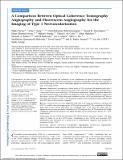A Comparison Between Optical Coherence Tomography Angiography and Fluorescein Angiography for the Imaging of Type 1 Neovascularization
Author(s)
Inoue, Maiko; Jung, Jesse J.; Balaratnasingam, Chandrakumar; Dansingani, Kunal K.; Dhrami-Gavazi, Elona; Suzuki, Mihoko; de Carlo, Talisa E.; Shahlaee, Abtin; Klufas, Michael A.; El Maftouhi, Adil; Duker, Jay S.; Ho, Allen C.; Maftouhi, Maddalena Quaranta-El; Sarraf, David; Freund, K. Bailey; ... Show more Show less
DownloadInoue-2016-A Comparison Between.pdf (1.291Mb)
PUBLISHER_CC
Publisher with Creative Commons License
Creative Commons Attribution
Terms of use
Metadata
Show full item recordAbstract
Purpose: To determine the sensitivity of the combination of optical coherence tomography angiography (OCTA) and structural optical coherence tomography (OCT) for detecting type 1 neovascularization (NV) and to determine significant factors that preclude visualization of type 1 NV using OCTA.
Methods: Multicenter, retrospective cohort study of 115 eyes from 100 patients with type 1 NV. A retrospective review of fluorescein (FA), OCT, and OCTA imaging was performed on a consecutive series of eyes with type 1 NV from five institutions. Unmasked graders utilized FA and structural OCT data to determine the diagnosis of type 1 NV. Masked graders evaluated FA data alone, en face OCTA data alone and combined en face OCTA and structural OCT data to determine the presence of type 1 NV. Sensitivity analyses were performed using combined FA and OCT data as the reference standard.
Results: A total of 105 eyes were diagnosed with type 1 NV using the reference. Of these, 90 (85.7%) could be detected using en face OCTA and structural OCT. The sensitivities of FA data alone and en face OCTA data alone for visualizing type 1 NV were the same (66.7%). Significant factors that precluded visualization of NV using en face OCTA included the height of pigment epithelial detachment, low signal strength, and treatment-naïve disease (P < 0.05, respectively).
Conclusions: En face OCTA and structural OCT showed better detection of type 1 NV than either FA alone or en face OCTA alone. Combining en face OCTA and structural OCT information may therefore be a useful way to noninvasively diagnose and monitor the treatment of type 1 NV.
Date issued
2016-07Department
Massachusetts Institute of Technology. Department of Electrical Engineering and Computer Science; Massachusetts Institute of Technology. Research Laboratory of ElectronicsJournal
Investigative Opthalmology & Visual Science
Publisher
Association for Research in Vision and Ophthalmology
Citation
Inoue, Maiko et al. “A Comparison Between Optical Coherence Tomography Angiography and Fluorescein Angiography for the Imaging of Type 1 Neovascularization.” Investigative Opthalmology & Visual Science 57.9 (2016): OCT314. © 2015 Association for Research in Vision and Ophthalmology
Version: Final published version
ISSN
1552-5783